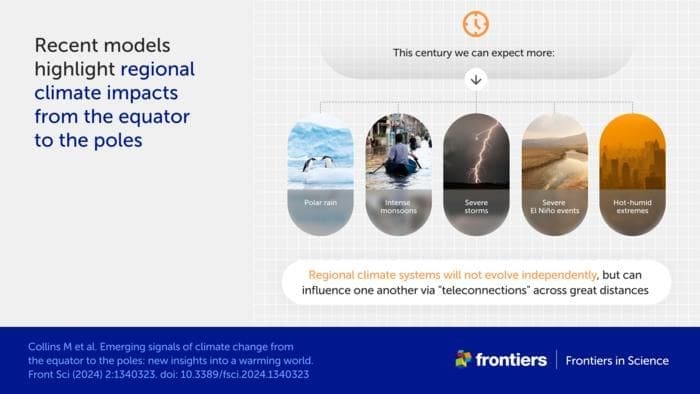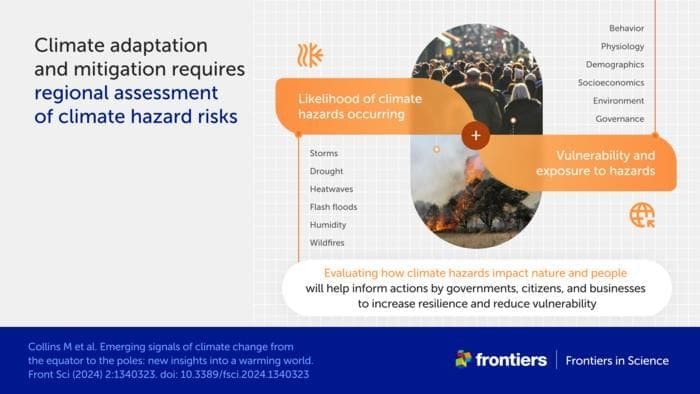A recent study published in Frontiers in Science underscores the importance of understanding regional climate change impacts to guide effective adaptation policies.
This synthesis of multiple new studies, titled Emerging signals of climate change from the equator to the poles: new insights into a warming world, highlights the diverse climate change signals from intensified monsoons and storm tracks to shifting polar precipitation patterns. It stresses the urgent need for climate adaptation policies informed by the latest regional climate science.
In 2023, extreme weather events touched every inhabited continent, demonstrating that climate change is already impacting communities globally. Flooding, droughts, and wildfires are no longer distant possibilities but present realities. While much attention focuses on global metrics such as rising temperatures, understanding regional climate impacts is critical for safeguarding communities from these escalating risks.

Matthew Collins, the study’s lead author and climate scientist at the University of Exeter, UK, highlighted the growing significance of regional climate data: “We are constantly advancing our understanding of climate change, particularly its regional aspects, to inform policies aimed at adaptation. While global aspects remain important, humanity will feel the impact of climate change at the regional level. This is where infrastructure planning, extreme event preparedness, and management of public health and food security need to up-to-date climate science.”
Regional impacts and rising risks
The study reveals a series of emerging climate change signals that span regions from the tropics to the poles, all of which are likely to intensify over the century.
In tropical and subtropical zones, monsoon systems – which are vital for agriculture and water resources – are expected to change dramatically. These systems provide up to 80% of the annual rainfall for nearly 60% of the global population living in the northern hemisphere’s monsoon regions. Rising greenhouse gas emissions and declining aerosol pollution are predicted to intensify monsoon precipitation, potentially leading to catastrophic floods, landslides, and disruptions in food production. This situation threatens the livelihoods of billions who rely on these seasonal weather patterns.
In the mid-latitudes, the study’s high-resolution climate models predict the intensification of storm tracks into northwestern Europe. This shift raises concerns about more frequent extreme weather events, including storms with high winds and heavy rainfall, which could lead to widespread agricultural damage and infrastructure disruptions.
Co-author Vikki Thompson, a climate expert at the Koninklijk Nederlands Meteorologisch Instituut (KNMI) in the Netherlands, warned: “Increased monsoon precipitation and storm track rainfall variability can lead to droughts in some regions and high winds and flooding in others, resulting in devastating impacts on agriculture, essential infrastructure, and the overall health of communities.”
At the poles, shifts in precipitation are accelerating, with more rain expected in regions that traditionally receive snowfall. This change could lead to faster ice melt, amplifying global sea-level rise and posing severe threats to coastal populations worldwide. The study also draws attention to the phenomenon of polar amplification, where the Arctic and Antarctic regions are warming faster than the global average. These changes could disrupt mid-latitude weather patterns, exacerbating extreme weather events far beyond the polar regions.

Advanced climate models as tools for adaptation
The researchers emphasize the need for improved climate models to aid in regional adaptation efforts. New climate modeling techniques, including high-resolution data and the integration of machine learning, are critical for capturing the complexities of climate systems at both the global and regional levels. Such advancements will allow scientists and policymakers to better predict and prepare for climate-induced disruptions.
Eunice Lo, a co-author from the University of Bristol, UK, points out that more precise models are essential for informing both international climate agreements and local adaptation measures. Lo emphasized that local strategies – ranging from resilient infrastructure development to enhanced early-warning systems and sustainable agriculture – must be rooted in the best available data.
Matt Priestley, another co-author from the University of Exeter, reinforced the importance of data-driven adaptation: “Regional information is essential for preparing for these extreme events and implementing effective, science-led adaptation measures. Without investments into advanced climate modeling and monitoring systems, policymakers and local communities are left navigating climate risks with insufficient information, which can lead to inadequate or misdirected efforts.”
The study’s findings point to the urgent need for a concerted interdisciplinary effort to bridge the gaps in climate modeling and policy implementation. As climate impacts become more pronounced at the regional level, adaptation strategies must be informed by the most reliable and up-to-date climate data.
While global efforts to mitigate greenhouse gas emissions remain essential, the authors argue that adaptation policies tailored to regional realities will be critical in the coming decades. By using enhanced models and high-resolution data, policymakers can take steps to protect communities from the escalating climate risks, ensuring that adaptation strategies are resilient, equitable, and rooted in science.
Journal Reference:
Collins Matthew , Beverley Jonathan D. , Bracegirdle Thomas J. , Catto Jennifer , McCrystall Michelle , Dittus Andrea , Freychet Nicolas , Grist Jeremy , Hegerl Gabriele C. , Holland Paul R. , Holmes Caroline , Josey Simon A. , Joshi Manoj , Hawkins Ed , Lo Eunice , Lord Natalie , Mitchell Dann , Monerie Paul-Arthur , Priestley Matthew D. K. , Scaife Adam , Screen James , Senior Natasha , Sexton David , Shuckburgh Emily , Siegert Stefan , Simpson Charles , Stephenson David B. , Sutton Rowan , Thompson Vikki , Wilcox Laura J. , Woollings Tim, ‘Emerging signals of climate change from the equator to the poles: new insights into a warming world’, Frontiers in Science 2 (2024). DOI: 10.3389/fsci.2024.1340323
Article Source:
Press Release/Material by Frontiers
Featured image credit: stokpic | Pixabay




